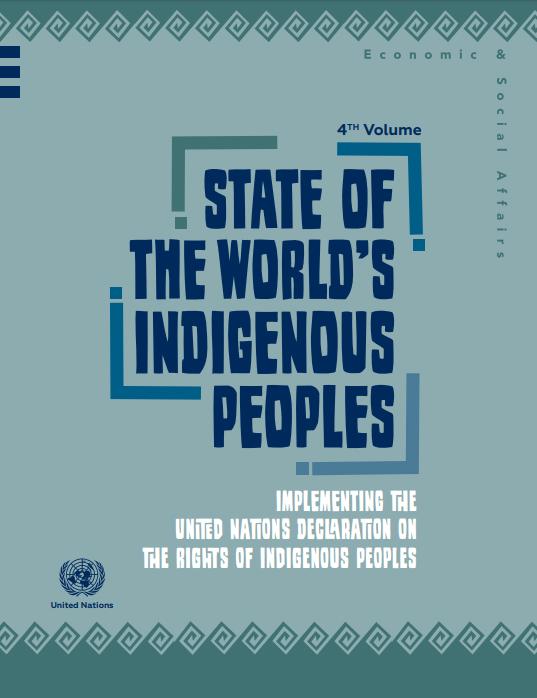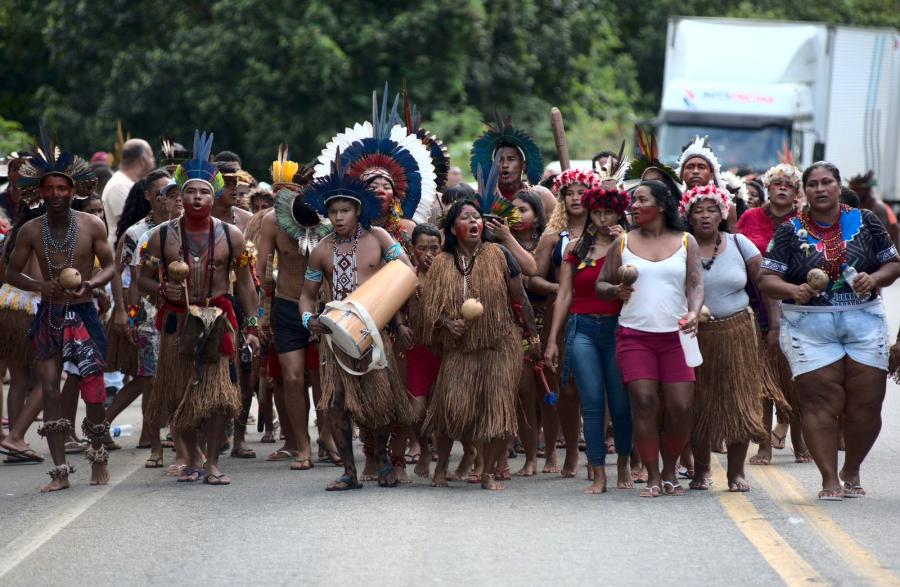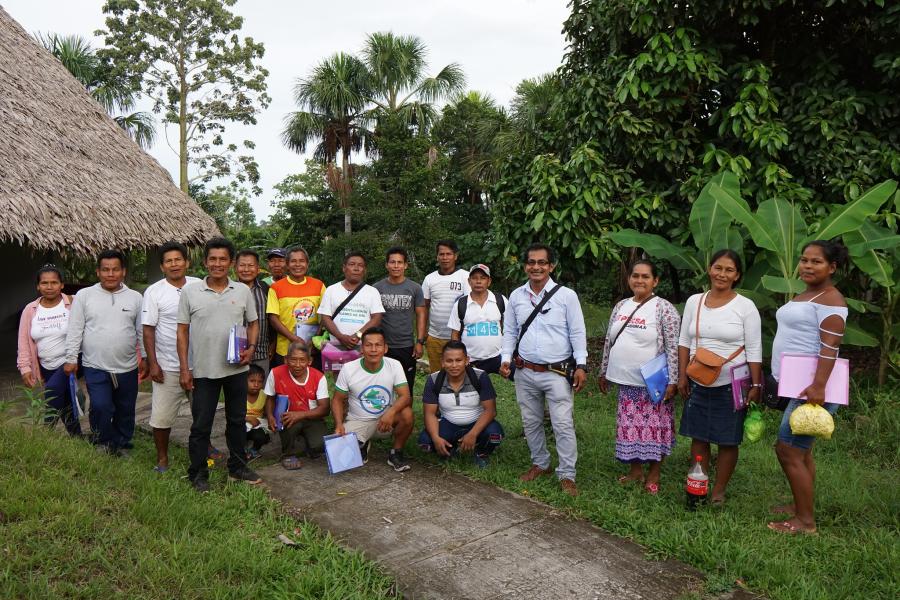
By Dillon Kim
The 4th edition of the State of the World’s Indigenous Peoples: Implementing the United Nations Declaration on the Rights of Indigenous Peoples was released on September 17, 2019 by the United Nations. The report’s authors-- the Department of Economic and Social Affairs Division for Inclusive Social Development, Indigenous Peoples and Development Branch, and the Secretariat of the Permanent Forum on Indigenous Issues-- look back at the past 12 years since the adoption of the United Nation Declaration on the Rights of Indigenous Peoples (UNDRIP) in 2007. They assess the multilevel, yet uneven progress that has been made at the international, national, and regional scale of implementing the declaration. The report begins with a series of questions, inquiring whether the declaration’s adoption in 2007 has made a difference? And if so, what challenges and gaps remain? The report acknowledges that major threats to the rights of the world’s Indigenous Peoples remain and identifies natural resource extraction, large scale agriculture, infrastructural development, and conservation development as major offenders in violating the rights of Indigenous Peoples.
The authors of this report conclude that while grave and significant challenges face the conditions of the rights of Indigenous people there is great reason for optimism in reviewing the progress made by the implementation of various aspects of the United Nations Declaration on the Rights of Indigenous Peoples. Miriam Wallet Aboubakrine (Tuareg), chair of the Permanent Forum on Indigenous Issues, notes that the formal recognition of Indigenous rights articulated in the Declaration has succeeded in bringing to the table multiple actors and stakeholders who have begun and carried on the work of making “the Declaration a living document and not just an empty promise.”
The report provides a framework for understanding how exactly the Declaration has been implemented and what this means at different levels of political life. From the realm of international organizations and governance, to national legislative bodies and courts, and regional inter-state bodies, the report details how the Declaration has been a source of revision and a mechanism for advancing further implantation of rights of Indigenous Peoples. The authors also note that language is a key aspect of implementation, as of 2019 the Declaration has been translated into 59 languages in addition to the UN utilized languages.
At the national level, the report highlights how legislative and judicial bodies have been influenced by the Declaration across continents. There are differences across regions, showing that there is a variable nature, particularly in the legislative adoption of the Declaration’s articles. In constitutional adaptation responding to provisions of the Declaration, Latin America holds some of the strongest, on paper, implementations. Bolivia is noted to be a unique case of integrating the Declaration into its domestic legislation, via Law No. 3760 in November of 2007. In juridical proceedings provide an overview of important court cases that have been influenced by the articles of the Declaration. Domestic “courts in Belize, Botswana, Canada, Chile, Colombia, Guatemala, Kenya, Mexico, the Russian Federation, and others have cited the Declaration in decisions involving Indigenous Peoples.”
Regional level governance and juridical proceedings have shown in the past 12 years to be influenced in many instances by the adoption of the Declaration by the UN General Assembly. The report highlights several inter-state and regional bodies like the European Union, the Organization of American States, the Nordic/Euro-Arctic Cooperation, along with the Inter-American Court of Human Rights, the African Commission and Court on Human Rights all sharing significant instances of drawing inspiration from the Declaration. Several cases that stand out are the European Union’s External Policy on Indigenous Peoples from 2016, the Nordic Sámi Convention, and the Endorois Welfare Council v. Kenya decision adopted by the African Union on 2 February 2010. These cases provide insights into how bodies of governments long attributed with colonization and the gross disrespect of the rights of Indigenous people, as in the EU External Policy on Indigenous Peoples can take a positive turn a la support of the Declaration in the international sphere. The authors note that the Nordic Sámi Convention provides a potentially relevant framework for transnational populations of Indigenous people to structure regional bodies for the advancement of their rights. In the case of Endorois v. Kenya, this ruling was the first in Africa to expressly recognize African Indigenous Peoples’ rights to ancestral lands setting an important precedent in the regional courts of the African Union.
By way of concluding on the implementation, the consideration of how the articles of the Declaration have been regarded at the international level by international governing bodies and the vital importance of these tenants as it regards the rights of women and children suffices to provide insight into the report’s key observations. Attention is made towards the widespread and growing mainstream recognition of Indigenous Peoples in the Indigenous-specific mechanisms in the UN and the increased consideration of Indigenous Peoples in UN Treaty Bodies.
In examining the specific and distinct status of Indigenous women and children we see the divergence of where there has been success and where tremendous work remains to be done. The cases detailed by the report show how Indigenous women have been at the forefront of the struggle to implement the articles of the Declaration and have provided leadership in the cases of the gravest injustices. Insight is presented on the remaining gaps of implementation, where Indigenous women still are subject to lack of protection by states and remain a critically high risk of violence and sexual violence.
The State of the World’s Indigenous Peoples report finds a serious lacking when it comes to how states are taking national censuses, resulting in a persistent “statistical invisibility” of Indigenous people. The lack of concrete disaggregated data only worsens this problem. Disaggregated data, being data, figures, and demographics that are broken down into categories relevant for understanding who is really being counted. The UN Statistical Division and UN Sustainable Development Goals agree that disaggregated data is crucial for states to be able to address the gross inequalities and discrimination that Indigenous Peoples face. Sadly, only 23.1% of national censuses (43 out of 184 countries) attempt to collect information on some or all Indigenous people represented in their area of survey. The authors observe that the Americas and Oceania fair slightly better in this regard yet are by no means perfect. Asian states, which are home to 3/4 of the world’s Indigenous population are particularly resistant to gathering this disaggregated data which would provide clear pictures of Indigenous people living in Asia.
Recognition of and respect for Indigenous Peoples and their rights; assessment of progress made in the implementation of the Declaration, awareness, information, and coordinated action; and practical constraints are four critical areas highlighted as priorities in approaching the rights of the world’s Indigenous Peoples. Recognition still remains of vital importance;
“Many in indigenous communities have been subjected to violent attacks and threats, enforced disappearances, illegal surveillance and travel bans. Women, persons with disabilities, and other vulnerable or marginalized groups within indigenous populations face particular challenges. The number of indigenous human rights defenders who die every year while attempting to defend their rights under the Declaration is on the rise. There is a growing trend towards criminalizing indigenous activists, organizations and movements, often engendered by conflicts over investment projects in indigenous territories.”
The report argues that the mechanisms of assessment by the UN of the state of implementation of the Declaration remains a vital role in the advancement of the goals and aims of the Declaration in the advancement of the rights of Indigenous Peoples. Further, the raising of awareness and coordination of action is identified as an important priority.
The report concludes with a five-point recommendation scheme, to:
- Strengthen and Coordinate the Roles of Indigenous-Specific UN Mechanisms
- Strengthen the Role of the Inter-Agency Support Group on Indigenous Issues
- Ensure the Sustainable Development Goal Processes Focus More Strongly and Explicitly on Indigenous People
- Ensure the Respect for Indigenous Peoples within the Private and Public Sectors
- Strengthen Capacity, Networking, and Strategizing Among Indigenous People
The report highlights the foundational role that Indigenous people play within these goals. The importance of Indigenous people leading the decision-making processes that affect their communities and future is paramount.



